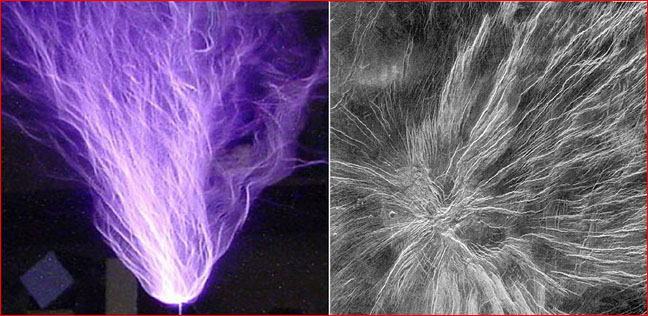
home •
about •
essential guide •
picture of the day •
thunderblogs •
news •
multimedia •
predictions •
products •
get involved •
contact

Credit: Left, a laboratory arc, courtesy of John Dyer. Right: The Mokos Nova now renamed "Tsían
Nu Mons" in Phoebe Regio of Venus. The scale across the image is about 560 km. NASA/JPL/Magellan Team
pic of the day
archive
subject index
abstract
archive
Links:
Society for
Interdisciplinary
Studies
Feb 16, 2005
Electric Scars on Venus
Perhaps the fastest way to understand the surface features on rocky bodies in the solar system is to look at the behavior of electric arcs. How does the electric discharge behave in different conditions, and what are the effects on different surface materials? The beautiful arc on the left above is provided by John Dyer, who has experimented with arc formations for many years.
On the right is an analogous "coronal" feature on the surface of Venus. The complexity of the "fine brushstroke" pattern has provoked exclamations of wonder. Some planetary scientists refer to the filamented striations as "cracks" or "graben" caused by upwelling sub-surface lava. But the pattern is typical of massive scarring across the entire equatorial region of Venus. The lava must be welling up around the entire circumference of the planet like air being blown into a balloon!
In the electric hypothesis, these coronal features are sinuous rilles, spidery filaments of "Lichtenberg figures" created by planet-wide discharge. Ancient peoples around the world knew the planet as "the long-haired" or "fiery-haired" star. On this basis alone one would find the similarity between Dyerís electric arc and the surface feature of Venus to be predictable. Electric arcs, similar to John Dyerís arc but scaled up to the size of continents, flared across Venusís surface and etched their thread-line forms into the rock.
Dyerís arc also bears close similarities to the tails of comets. This convergence of form and theory from laboratory to comet to ancient description provides new insight into the ancient insistence that the planet Venus was once a brilliant and terrifying form in the heavens, its long-flowing and disheveled "hair" streaming across the sky. (See forthcoming TPODs.)
For more exceptional pictures of electrical arcing: http://www.johndyer.com/sparxarcs.html
EXECUTIVE EDITORS:
David Talbott, Wallace Thornhill
MANAGING EDITOR: Amy Acheson
CONTRIBUTING EDITORS: Mel Acheson, Michael Armstrong, Dwardu Cardona,
Ev Cochrane, C.J. Ransom, Don Scott, Rens van der Sluijs, Ian Tresman
WEBMASTER: Michael Armstrong
Copyright 2005: thunderbolts.info